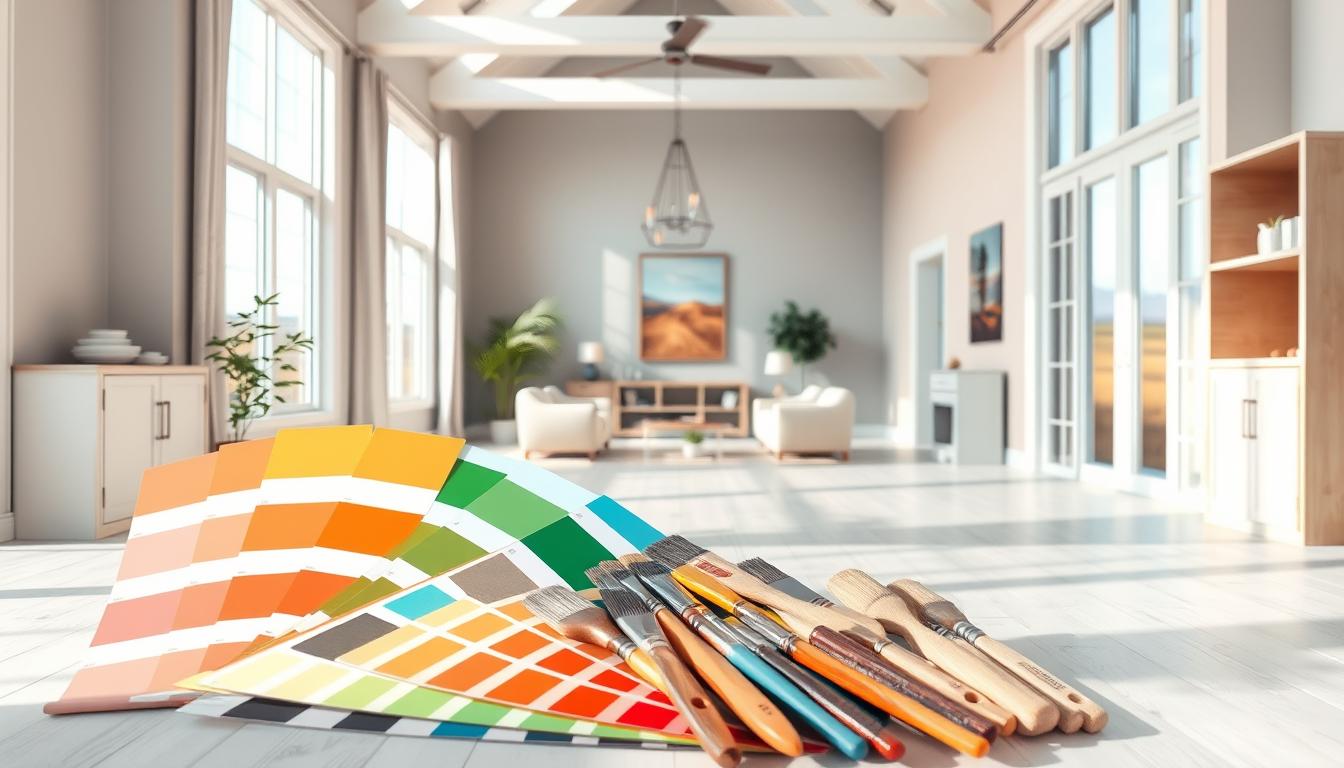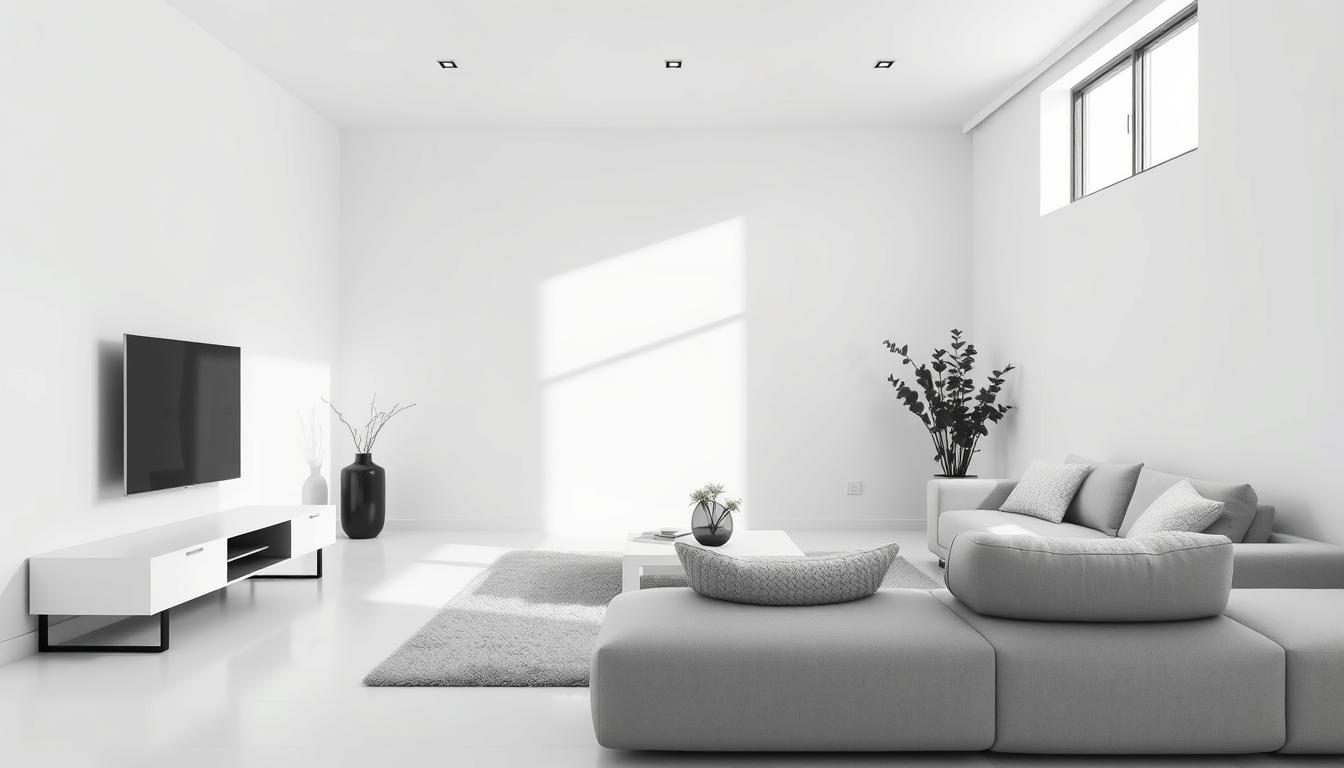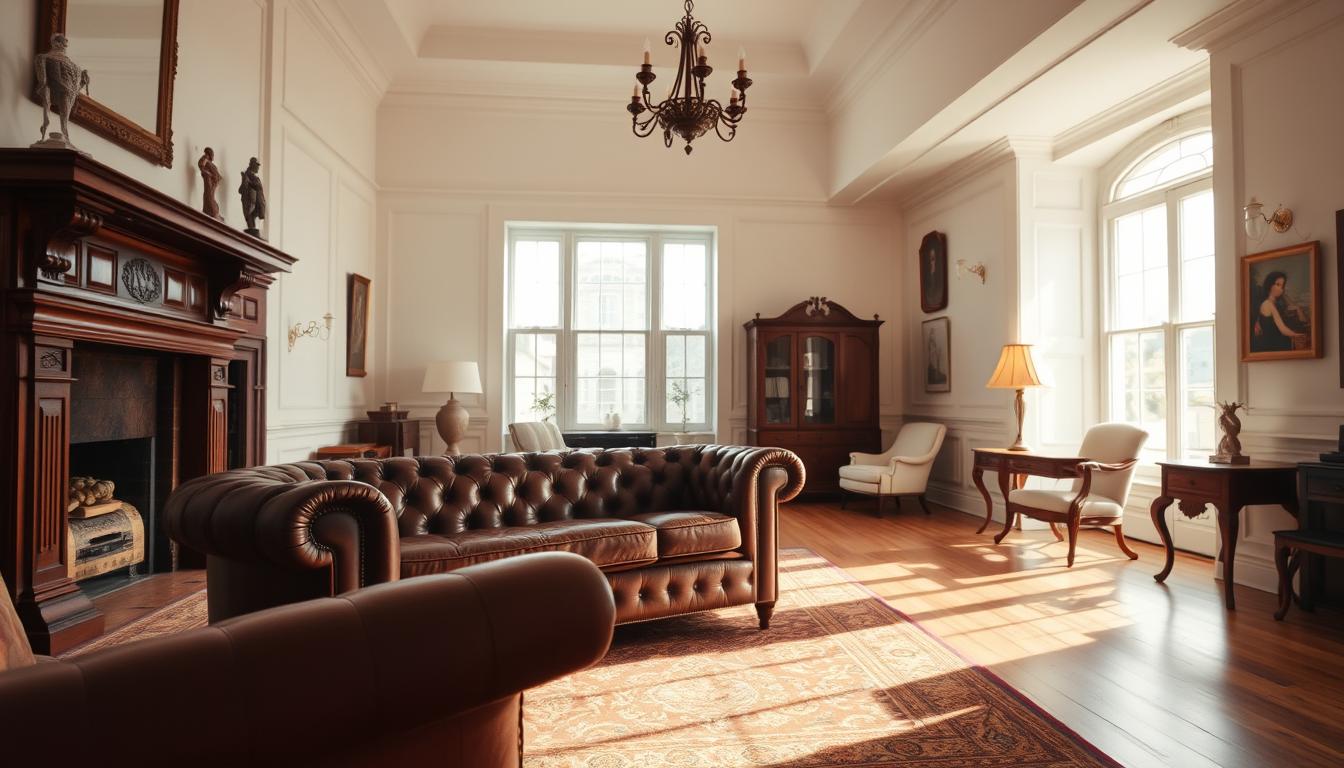Did you know that the color of your living space can really affect your mood and how well you work? Since most of us spend over 90% of our time indoors, picking the right interior paint is key.
Choosing the best paint means looking at color psychology, room size, and finish. We’ll help you understand these factors. This way, you can make a smart choice.
Knowing how colors and finishes work can turn your home into a space that shows off your personality. We aim to give you the info you need to pick the perfect paint for your home’s inside.
Key Takeaways
- Understand how color psychology affects your mood and productivity.
- Learn how to choose the right paint finish for different rooms.
- Discover the importance of considering room size when selecting paint colors.
- Get expert tips on how to pick the perfect paint color for your home.
- Explore the different types of paint and their characteristics.
Understanding Interior Paint Types
There are many interior paint options out there. It’s important to know what each type offers. The right paint can make your home look amazing. The wrong one can make it look less than perfect.
Latex vs. Oil-Based Paint
The choice between latex and oil-based paint is a common debate. Latex paint, or water-based paint, is easy to use and dries fast. It’s great for interior projects because it’s easy to clean up with soap and water.
Oil-based paint, or solvent-based paint, gives a hard, durable finish. It’s good for areas that get a lot of use or need to be cleaned often. But, it takes longer to dry and needs mineral spirits for cleaning.
Think about what you need for your project when choosing between latex and oil-based paint. Oil-based might be best for busy areas or surfaces that need frequent cleaning. Latex is usually a good all-around choice for most interior projects.
Specialty Paints: What to Know
There are also specialty paints for specific needs or looks. These include paints with unique finishes, like metallic or textured, and those that are better for indoor air quality. For more info on paint finishes and textures, check out Home Depot’s guide on paint finishes and.
Specialty paints can give your interior design a unique touch. But, it’s important to know what they offer and what they can’t do. Whether you want a certain look or a special benefit, there’s likely a specialty paint for you.
Choosing the Right Finish for Your Space
Understanding the different finishes for interior paint is key to achieving your desired look. The finish of your paint greatly affects your home’s look and feel. It can range from subtle and understated to bold and eye-catching.
Matte and Eggshell Finishes
Matte finishes have a flat, non-reflective surface. They are perfect for hiding imperfections on walls. They are often chosen for low-traffic areas like bedrooms and ceilings.
Eggshell finishes have a slightly higher sheen than matte finishes. They are more durable. This makes them great for areas that need a bit more resilience, like living rooms and dining rooms.
Both matte and eggshell finishes are good for a subtle look. But, they might not be the best for high-traffic areas or rooms with moisture, like kitchens and bathrooms.
Satin and Semi-Gloss Options
Satin finishes have a gentle sheen that is more reflective than eggshell but less than semi-gloss. They are versatile and work well in many rooms, including kitchens, bathrooms, and hallways. They are durable and easy to clean.
Semi-gloss finishes are the most reflective and durable. They are perfect for trim work, doors, and windows. They also work well in areas exposed to moisture.
When choosing between satin and semi-gloss, think about the sheen you prefer and the area’s wear and tear. Semi-gloss is more resistant to moisture and easy to clean. But, it can highlight wall imperfections.
High-Gloss Paint: Pros and Cons
High-gloss paint has a shiny, reflective surface. It is very durable and easy to clean. It’s great for trim, doors, and windows. But, its high sheen can show wall imperfections, so the surface must be smooth before applying.
High-gloss paint’s durability is a big plus. It can handle heavy use and is resistant to moisture. It’s good for areas like kitchens and bathrooms. But, it can be too reflective for some settings.
| Finish Type | Sheen Level | Durability | Best Used In |
|---|---|---|---|
| Matte | Low | Low | Bedrooms, Ceilings |
| Eggshell | Low-Medium | Medium | Living Rooms, Dining Rooms |
| Satin | Medium | High | Kitchens, Bathrooms, Hallways |
| Semi-Gloss | High | Very High | Trim, Doors, Windows |
| High-Gloss | Very High | Extremely High | Trim, Doors, Windows |
By understanding each finish’s characteristics and your space’s needs, you can make a choice that enhances your home’s beauty and function.
Color Psychology and Home Interiors
Choosing the best interior paint for walls means understanding color psychology. Colors can change how we feel and the mood of a room.
Colors can make us feel different things. For example, blue and green calm us down, making them great for bedrooms. On the other hand, red and orange can make us feel more energetic, perfect for living rooms.
How Colors Affect Mood
Color’s effect on mood is complex. Studies show that colors can either calm or excite us. For example:
- Warm colors like red, orange, and yellow make our heart beat faster and get us talking.
- Cool colors such as blue, green, and purple help us relax, reducing stress and making us feel calm.
Knowing this can help us pick the right colors for our homes. It makes our living spaces better.
Choosing Colors for Different Rooms
Every room has its own purpose, and the colors should match. Here are some tips for picking colors for different rooms:
- Bedrooms should have calming colors like light blue or pale green to help us sleep better.
- Living rooms do well with warm colors that make us want to talk and socialize.
- Kitchens and dining areas can be brightened with colors that make us hungry, like red or orange.
By picking the best interior paint for walls for each room, we can make our homes both beautiful and functional.
Popular Paint Brands for Home Interiors
Many paint brands are out there, but some stand out as leaders. They offer a variety of products for different needs. When picking a paint brand, think about quality, color options, and price.
Benjamin Moore: A Trusted Choice
Benjamin Moore is known for its top-notch paints. They last long and keep their color well. They have many finishes, from matte to glossy, to match any design.
Key Features of Benjamin Moore Paints:
- High-quality ingredients for durability
- Wide range of color options
- Variety of finishes to suit different decor styles
Sherwin-Williams: Quality and Variety
Sherwin-Williams is a top brand with a huge color range and high-performance paints. Their paints last a long time and come in many finishes. A recent review said, “Sherwin-Williams paints are easy to apply and have a great finish.”
Notable Aspects of Sherwin-Williams:
- Extensive color palette to match any decor
- High-performance products for durability
- Innovative products for specific applications
Behr: Affordable Alternatives
Behr is a favorite for those who want quality paint at a good price. Their paints cover well and last long, making them a smart choice. A happy customer said, “Behr paints are a great mix of quality and price, perfect for DIY projects.”
Benefits of Choosing Behr:
- Affordable pricing without compromising on quality
- Excellent coverage and durability
- Wide range of colors and finishes available
In summary, Benjamin Moore, Sherwin-Williams, and Behr are great options for home paint. They offer quality, variety, and good prices. Think about what you need and choose the best brand for your project.
Preparing Your Walls for Painting
To get the most out of your durable interior paint for homes, proper wall preparation is key. A well-prepared surface ensures a smooth, long-lasting finish. This enhances the beauty of your interior spaces.
Before applying paint, clean and repair your walls. Dirt, grime, and grease can harm paint adhesion, causing a poor finish. Use a mild detergent and water to clean the walls well. For tough stains or grease spots, a trisodium phosphate (TSP) solution works well.
Cleaning and Repairing Surfaces
Repairing damaged surfaces is another critical step. Fill holes or cracks with a suitable filler and sand it smooth. For big damage, use a patching compound. Sanding after repairs helps create a uniform base for painting.
“The key to a successful paint job is in the preparation,” says a renowned interior designer. “Taking the time to properly clean and repair your walls can make all the difference in the final result.”
The Importance of Primer
Using a primer is a crucial step that should not be skipped. Primer creates a uniform surface, improves paint adhesion, and covers stains or discolorations. For best results, choose a primer that matches your paint type (latex, oil-based, etc.).
By following these steps, you can ensure your walls are ready for painting. This results in a beautiful, durable interior paint for homes that will last for years.
Tools You’ll Need for Painting
To get a professional look, you need the right painting tools and quality paint. The right tools make the job easier and ensure paint goes on smoothly.
Brushes, Rollers, and Sprayers
For painting, you’ll need brushes, rollers, and sprayers. Each tool has its own use and benefits.
- Brushes: Great for trim and detailed areas. Natural bristles work best with oil-based paints, while synthetic brushes are better for latex.
- Rollers: Ideal for big, flat areas. Choose the right roller nap for your surface.
- Sprayers: Good for smooth finishes on large or detailed areas. They can be tricky to use but look professional.
Experts say, “The right tool is key for painting. It’s not just about painting; it’s about creating a lasting finish.”
“A good painter is not just someone who applies paint, but an artist who understands the nuances of color and texture.” –
Essential Painting Accessories
There are also accessories that can make painting better.
| Accessory | Description | Benefit |
|---|---|---|
| Paint Tray | A container for paint and roller | Makes painting easier by keeping tools handy |
| Painter’s Tape | Adhesive tape for masking off areas | Helps create sharp lines and edges |
| Drop Cloths | Protective coverings for floors and furniture | Prevents paint spills and stains |
Using the right accessories can really improve your painting. For example, painter’s tape helps with sharp edges, and drop cloths protect surfaces from paint.
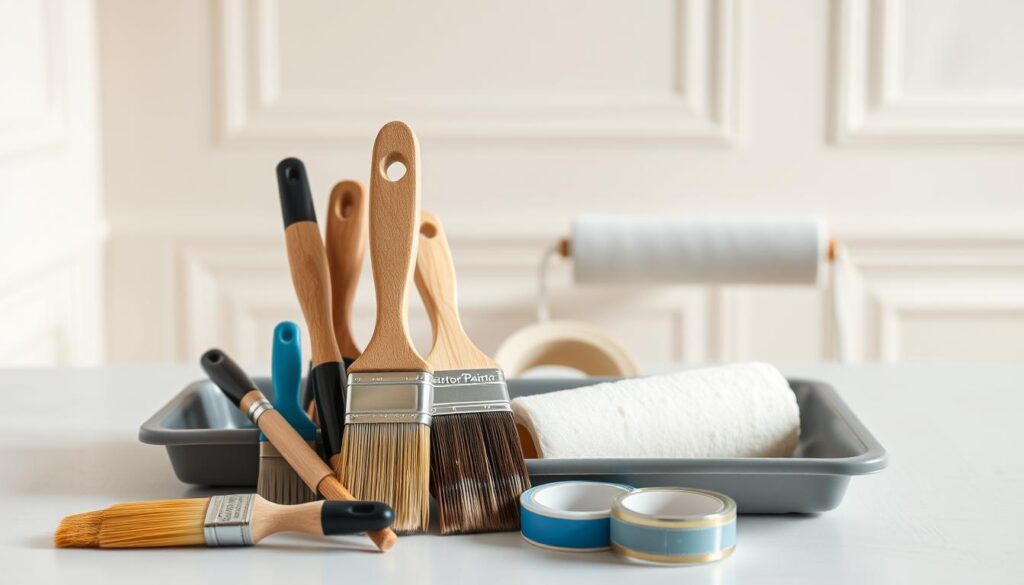
With the right tools and accessories, you’ll get a professional finish with your top-rated paint for interior walls.
Budgeting for Your Interior Painting Project
Setting a realistic budget is key when planning an interior painting project. It ensures you get the results you want without overspending. A good budget helps you choose the right paint and plan your project.
Estimating Paint Costs
The cost of paint is a big part of your budget. Consider these factors to estimate paint costs:
- The size of the area to be painted
- The type and quality of paint you choose, such as premium paint for home interiors
- The number of coats you plan to apply
A gallon of high-quality interior paint can cost $30 to $60. For a typical room, you might need 1-2 gallons. This depends on the area and paint coverage.
Additional Expenses to Consider
There are other costs to add to your budget:
- Primer: Primer costs can add up. Prices are similar to paint.
- Tools and Equipment: Brushes, rollers, and trays cost $50 to $200. This depends on quality and brand.
- Labor: Hiring a pro will increase your costs. Expect to pay $30 to $100 per hour per painter. This varies by location and job complexity.
To stay on budget, get quotes from different suppliers and contractors. This helps you find the best value for your money.
By accurately estimating paint costs and considering other expenses, you can make a detailed budget. This way, you can achieve your painting goals without financial worries.
Eco-Friendly Paint Options
More people are now looking for eco-friendly paint options. This is because they want to reduce their environmental impact. They seek sustainable and healthy painting solutions.
Low-VOC and Zero-VOC Paints
Low-VOC and zero-VOC paints are big steps forward in eco-friendly painting. VOCs are chemicals that evaporate and can harm health and the environment. Low-VOC paints have fewer VOCs than regular paints. Zero-VOC paints have almost no VOCs, perfect for indoor painting.
These paints make indoor spaces healthier and reduce environmental harm. By picking low-VOC or zero-VOC paints, homeowners avoid harmful chemicals. They also support sustainable practices.
Benefits of Sustainable Choices
Choosing eco-friendly paints has many advantages. They improve air quality indoors, making homes healthier. They are also made from natural ingredients and have less environmental impact.
- Improved indoor air quality
- Reduced environmental impact
- Healthier living spaces
- Support for sustainable manufacturing
Many eco-friendly paint brands now offer a wide range of colors and finishes. This makes it easy for homeowners to find the right shade without giving up their values. Choosing eco-friendly paints is a way to make our homes more sustainable.
Hiring a Professional vs. DIY Painting
Choosing whether to hire a painter or do it yourself is a big decision. Both options have their good and bad sides. We’ll look at these to help you decide.
Pros and Cons of Hiring a Painter
Hiring a painter can save you time and ensure a top-notch finish. They know how to get surfaces ready and paint evenly. This means your home will look great and last longer.
But, hiring a painter can cost a lot. Labor costs can add up quickly. You also need to find a reliable painter by doing some research.
| Aspect | Hiring a Professional | DIY Painting |
|---|---|---|
| Cost | Higher due to labor costs | Lower, as you’re saving on labor |
| Quality of Finish | High-quality finish expected | Dependent on your skill level |
| Time Commitment | Less time-consuming for you | More time-consuming as you’ll be doing the work |
Tips for a Successful DIY Experience
If you choose to paint yourself, here are some tips. First, properly prepare your surfaces. Clean and fix them as needed for a smooth finish.
Next, choose the right tools. Good brushes and rollers make a big difference. Also, use a primer if you’re painting over dark colors or stains.
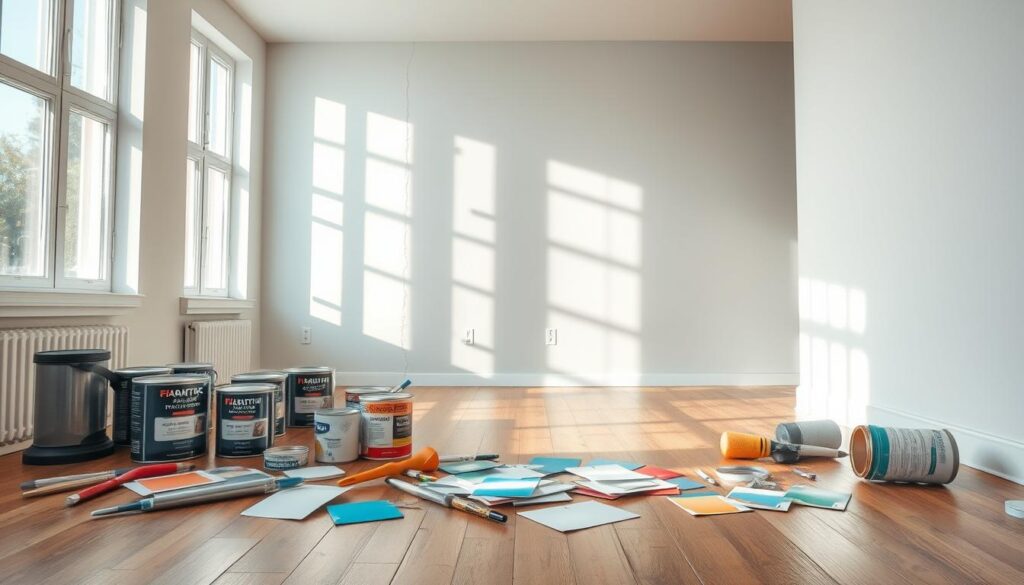
Lastly, don’t rush. Let each coat dry as the maker says before adding more. This patience will lead to a professional-looking finish.
Maintenance Tips for Painted Walls
To keep your interior paint looking great, regular care is essential. Using high-quality paint for your home interior is just the start. Keeping your walls clean and fixing any damage fast is also key.
Cleaning Techniques for Longevity
Cleaning your painted walls often helps stop dirt and grime from harming the paint. A soft cloth or sponge with mild soap and water usually works well. Stay away from harsh chemicals or abrasive cleaners, as they can harm the paint or finish.
For tough stains, a gentle cleaning product made for painted surfaces might be needed. For more detailed advice, check out Benjamin Moore’s guide on cleaning painted walls.
Touch-Up Strategies
Even with care, accidents can still happen, leaving scratches or stains on your walls. Having a plan for touch-ups can help fix these issues fast. Keep some of your original paint for touch-ups, blending the new paint with the area around it.
For small scratches, use a fine-tip brush to paint the damaged spot. For bigger areas, you might need to repaint the whole wall for a smooth finish.
Regular care and quick touch-ups can make your paint last longer. By following these easy tips, your home’s painted walls will stay beautiful for years.
Trends in Interior Paint Colors
Interior design is always changing, and knowing the latest paint colors is key for homeowners. Choosing the right colors can greatly change how our homes feel and look.
Popular Shades for 2023
This year, we’re seeing a shift towards colors that reflect personal style and promote well-being. Soft neutrals and earth tones are becoming more popular. They create a calm and welcoming atmosphere.
Some standout shades include:
- Warm beiges and taupes, which add a cozy feel to any room.
- Soft blues and greens, inspired by nature, these colors bring a sense of serenity.
- Rich terracottas, adding a touch of warmth and sophistication.
How to Stay Timeless
While trends are inspiring, it’s also key to pick colors that won’t fade fast. For a timeless look, consider these tips:
- Choose classic neutrals that have stayed popular over the years.
- Use bold colors sparingly, like on an accent wall, to add personality without overwhelming the space.
- Think about the natural light in your rooms and how it affects the color throughout the day.
By mixing current trends with timeless choices, you can create a beautiful and lasting interior that shows off your personal style.
Final Thoughts on Choosing the Best Paint
Choosing the best paint for your home is more than just picking a color. You need to think about the type of paint, finish, and brand. Also, durability and eco-friendliness are important factors.
Finding the right balance between color and quality is key. The best interior paint for walls makes your space look great and keeps your walls looking good for years. Using durable interior paint for homes means you won’t have to paint as often.
Reflecting Your Personal Style
Your personal style is important when picking paint. Whether you like bold colors or soft tones, your paint should show your taste. Think about your lifestyle, decor, and the mood you want in each room. This helps you choose paint that brings your vision to life.

